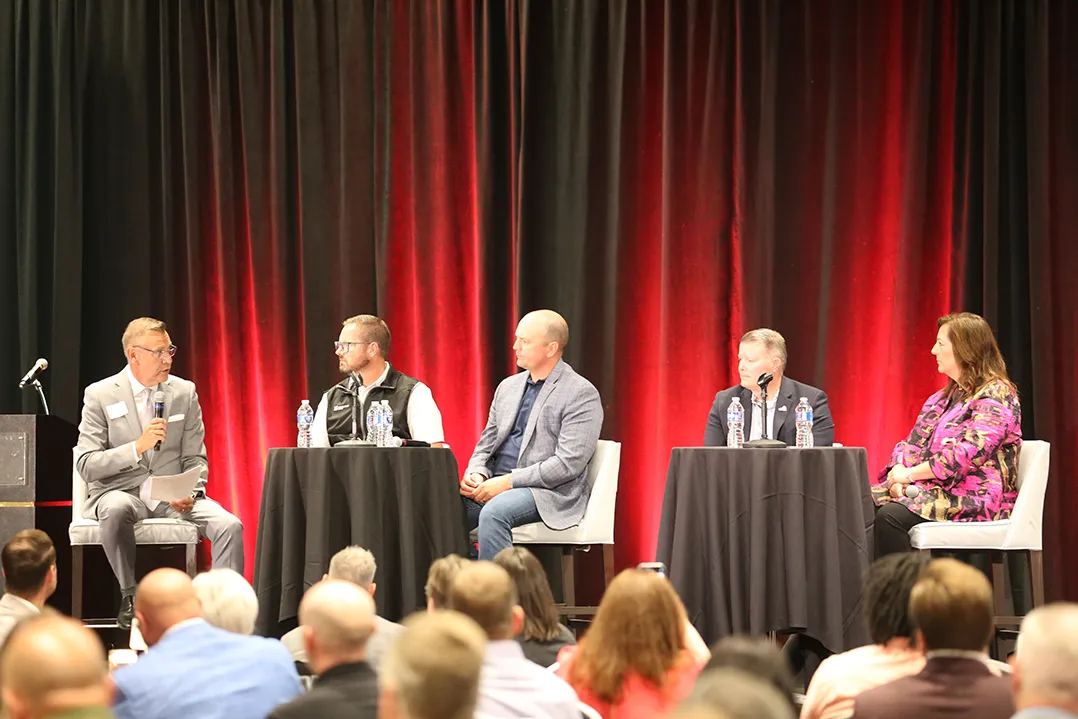By Ann Marie Shambaugh and Adanna Mbanu
The four mayors of Hamilton County’s largest cities participated in a panel discussion June 18 as part of the Hamilton County Leadership Academy’s Leadership Summit at the Embassy Suites Conference Center in Noblesville.
Carmel Mayor Sue Finkam, Noblesville Mayor Chris Jensen, Fishers Mayor Scott Fadness and Westfield Mayor Scott Willis answered questions about regionalism and collaboration from Terry Anker, dean of the HCLA Class of 2014.
Collaboration, competition
Anker asked the mayors how they balance collaboration and competition with neighboring communities as they make decisions for their own city.
Jensen said he considers other regions – such as the Denver, Colo., or Nashville, Tenn., areas – as competitors more than other municipalities in Hamilton County.
“Indiana is known for its Hoosier humility,” he said. “We need to chuck that Hoosier humility and decide if we want to be a global competitor, we have to be going forward. We have to tell our story. We have to tell our metrics and we have to push each other to get those metrics better.”
Fadness said Hamilton County municipalities often look for ways to work together, but even when they are in competition it can benefit the region as a whole.
“The relationships among cities in Hamilton County have matured to a point now where we understand that there are seasons where we will compete,” Fadness said. “When a company comes to Hamilton County and is looking around, every one of us is going to put our best foot forward. That’s what we’re supposed to do. But you know what? If I don’t win and (Noblesville) wins it or (Carmel) or (Westfield), that’s great. It’s good for the collective.”
Inspired innovation
Another question focused on how innovation plays into shaping Hamilton County communities.
Finkam said Carmel has long been a leader in innovative thinking, citing the city’s transformation of most of its signaled intersections to roundabouts.
She said innovation is sparked by listening to the stories and experiences of a variety of residents and stakeholders.
“I’m trying to bring people from our community into projects and committees to make them richer and different, because I think we all get stuck in one particular mindset,” she said. “And I think when we talk about diversity, part of this is diversity of thought, and making sure really we’re growing our minds on what is possible, even if it takes change, to get it done.”
Willis said Westfield and other local leaders have been inspired by several innovations in Carmel, such as limiting suburban sprawl and building walkable communities.
“Carmel set that standard and I think every single city here is taking pieces of that and transforming it into something that’s unique for their community,” Willis said. “We’re following that walkability component to attract future generations.”
Which tools are missing?
Anker asked the mayors which resources they have to make their jobs more manageable and which ones they wish they had.
Willis said that two years ago, Westfield had “gone into a shell” and wasn’t a pro-growth town. But he said the town’s involvement with the Central Indiana Regional Development Authority helped them move forward.
“We’re going to benefit from that in our community with a $4 million grant that we would have never had if we had not been a part of CIRDA,” Willis said. The grant will support Westfield’s Park and Poplar project establishing a central business district.
Finkam said that for Carmel to continue to prosper, it needs the state Legislature’s support.
“We’re the economic engine in this county and we’re continually tagged with the thought that we have everything we need, because we have a wealthy community,” Finkam said. “We’re also growing so quickly and infrastructure needs are astounding. We just want and need a system whereby we can, with our community’s support, put our necks out there and risk a little bit.”
Best advice
Anker ended the session by asking the mayors about the best leadership advice they have received.
Fadness said he’s learned to embrace humility.
“You’re never as good or as bad as what they say in the headlines in the newspaper. I think that’s really, really important,” Fadness said. “And then, I try to be engaged in whatever I’m doing at the moment.”
Jensen’s best piece of advice he’s been given is to “hire really smart people and then trust them.”
“My team (members) are 10 times smarter than I am and I trust them. I also ask them to push back on me at times,” Jensen said. “When you walk out the door, I’m going to go fall on the sword for it. But if there’s something that I’m going to step on and you don’t tell me, then that’s on you. So, hire smart people and trust them to do the work.”




